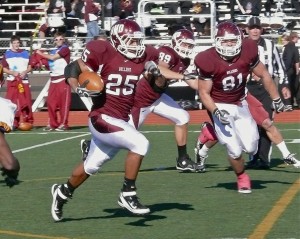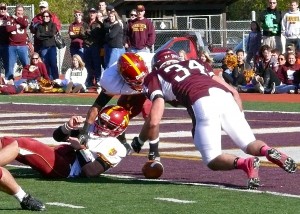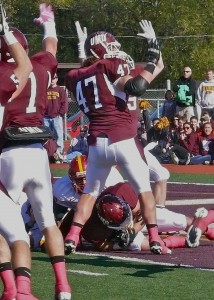When does a touchdown earn 2 points?

Zach Hulce, a transfer and senior, got his chance in the UMD backfield and promptly ran for two touchdowns against Northern State.
By John Gilbert
Watch sports live or on television, and no matter how many games you see, you’re likely to see something you’ve never seen before. Take the UMD football game against Northern State University last Saturday. There were no arguments, but there was one play that could be put in a time capsule to show how difficult the officials’ job can be, and raise some stimulating questions, at the same time.
When is a touchdown worth only two points? When is a safety actually a touchdown? When can a ball-carrier land on his backside on his 1-yard line, but be ruled in the end zone? When could one play be called any of three ways and a logical case could be made that any of the three was correct?
Only in a UMD football game, apparently. It happened at a crucial spot in last Saturday’s homecoming game, with the Bulldogs clinging to a 7-6 lead over Northern State of South Dakota. (Makes you wonder, by the way, if there’s a Southern State of North Dakota, doesn’t it?) Twice in the game, UMD’s hustling special teams attackers downed punts at the 1-yard line, putting the Wolves in serious trouble. On the second of these, in the second quarter, with UMD leading 7-6, the Bulldogs attacked on defense. On third and nine from the 3, Northern quarterback Nick Wanner tried to gain some running room, but was jolted at the line of scrimmage, and as he fell backwards the ball was fell loose for a fumble. As the ball landed in the end zone, UMD senior Derrick Zappa, who seemed to be in the middle of every Northern play all day, pounced on it. His teammates raised their arms, signaling “touchdown,†as one official, on the goal line, also signaled “touchdown.†Another official, however, signaled “safety,†and after a brief discussion, the ruling was for a safety, two points for the Bulldogs to increase a 7-6 lead to 9-6.

Northern State's Nate Wanner lost the ball before his tail-first landing just outside the end zone; the ball clearly was at rest over the goal line, as UMD's Derrick Zappa pounced to recover for an apparent touchdown.
As the accompanying photos indicate, Wanner’s rear end is down at about the 1, and his upper body is falling backwards, toward the goal line. The ball is already loose, on the turf in the end zone, as Zappa pounces on it. The case could be made for three possible rulings: (A.) Wanner was down where his butt hit the turf, before he lost possession, making it fourth down, Northern, on its 1; (B.) Wanner was going down, and his upper body wound up crossing the goal line before the fumble, so it was a safety; or (C.) Wanner fumbled as he was going down, so it didn’t matter where he or his butt landed, it was a loose ball, meaning touchdown UMD when Zappa recovered.

The Bulldogs celebrated a touchdown, but officials ruled it a safety, meaning Wanner was down, in the end zone, before he fumbled.
The officials chose “B†but it appeared evident to me (and my camera) that it had to be “C.â€Â I was walking the sideline, right near the goal line, and it was clear that the ball had come loose as Wanner was going down, and it landed on the ground as Wanner landed a few feet away. The ball had to still be in Wanner’s possession, with Wanner in the end zone, for it to be a safety, but clearly, no part of Wanner’s body crossed the goal line when he still had possession, so it couldn’t be a safety. The only plausible call was that it was a fumble, and a touchdown for Zappa and the Bulldogs. This is not so much a second-guess, as to relate the rarity of having three potential rulings on one play, and nobody on either side would have argued no matter which one they chose.
Fortunately, the Bulldogs went on to win 37-6 with a strong second half, and now stand 7-1 overall and 6-1 for a share of first place in the Northern Sun. The eventual title could well be determined Saturday, when the Bulldogs play at St. Cloud State. A huge factor for UMD was that freshman running back Austin Sikorski, who had broken loose for 185 yards the previous weekend, and gained 23 yards on five carries through the first quarter, mostly on UMD’s first touchdown drive, went out with a knee injury and was helped off the field.
Second-unit running back Brian Lucas, who often alternated with fellow-freshman Sikorski, finished off the first-quarter drive with a short touchdown run, and carried 16 times for an even 100 yards in the game. Coach Bob Nielsen had an interesting philosophy. “With Sikorski out, I tried to limit Lucas’s reps,†Nielsen said. So he went to third-unit transfer Zach Hulce.
Hulce, from outstate Washington, attended Glendale Community College in Arizona, then transferred to West Virginia, before being sidelined with a knee injury. He transferred to UMD, and has been waiting his chance as a senior. It appears he made a good choice. “I’m not really into the cold, but I like to win,†he said. Hulce carried 8 times for 85 yards, breaking free for two successive second-half touchdowns that turned a 16-6 lead to a 30-6 bulge. Hulce ran through an enormous hole for a 20-yard touchdown run in the third quarter, and blasted through several defenders before sprinting 44 yards for a fourth-quarter touchdown. Steve Ierilli, the fourth running back of the day, added 68 more yards on nine carries, mostly in the fourth quarter.
WCHA WOMEN’S RACE TIGHT
The UMD women’s hockey team played two strong games last weekend, but lost a wrenching 4-3 first game to Wisconsin at Amsoil Arena. The Bulldogs had a weird second game, heavily outshooting the Badgers, but lost 6-3 after a faltering first period. The Badgers have a lot of firepower returning from last year’s WCHA and NCAA champs, and deserve their No. 1 rating.
UMD can take inspiration from both losses, however. In the first game, after spotting Wisconsin a goal by Brianna Decker, freshman Jenna McParland scored twice to lift UMD to a 2-1 lead after one period. Her first goal came on a power play, when Haley Irwin squeezed a pass from deep on the right side through the crease — behind goalie Alex Rigsby — and McParland had a slam-dunk at the left post. Wisconsin turned up the attack in the second period, outshooting UMD 17-7, but had to wait until the closing minutes to get goals from Carolyne Prevost and Hilary Knight for a 3-2 lead at the second intermission. Audrey Cournoyer scored for UMD at 7:18 of the third, tying it 3-3, and the game seemed headed for overtime, until a Badger penalty gave UMD a late power play. But with 1:14 remaining, the irrepressible Knight broke free and scored on a shorthanded breakaway to give the Badgers a 4-3 triumph.
In the second game, UMD roared to the attack at the outset, outshooting the Badgers 12-3 for the first 14 minutes, but unable to get anything past goalie Alex Rigsby. When UMD got the only penalty of the first period, Hilary Knight (who else?) scored with a power-play slapshot at 17:05, then Brianna Decker scored at 18:04, and Kelly Jaminski scored at 18:39. The three Badger goals in a 1:34 span put the Badgers in command.
UMD fought back when Pernilla Winberg scored on Haley Irwin’s pass out, but Carolyne Prevost got her first of two goals and Saige Pacholok got another for a 5-1 Wisconsin lead.
Pacholok’s goal, at 18:16 of the middle period, was another one of those rarities. She was called for a delayed penalty for interference, and on the delay, goalie Jennifer Harss raced out of the UMD goal for a sixth attacker. UMD’s Vanessa Thibault had the puck deep in the right corner during the delayed-penalty advantage, and when she fed a pass back to the right point, it hopped the stick of Tea Villila at the point, and slid all the way down the ice — 175 feet or thereabouts, and right into the unguarded UMD net. Pacholok was sent to the penalty box for her delayed interference, and was later named as the official goal-scorer because she was last to touch the puck before UMD’s “own†goal-against.
UMD, which outshot the Badgers 23-7 in the second period, closed the deficit to 5-2 when Audrey Cournoyer scored on an Irwin rebound during a two-skater power play to end the middle session. And when Katie Wilson scored a power-play goal to open the third, it brought the Bulldogs up to 5-3. One more goal would have put them close enough for a pulled-goalie finish, but Prevost scored into the empty net with 24 seconds remaining to secure the 6-3 finish.
Wisconsin coach Mark Johnson said his Badgers might get an easy weekend, but he can’t envision it yet. “We started with North Dakota, then we split with Minnesota, then we come here to face the Bulldogs, and next weekend we play Boston University,†said Johnson. “North Dakota is definitely a top contender, and we beat Minnesota in a hard-fought game before they blitzed us in the second period. Same thing here against Duluth. It’s great for our league to have so many competitive teams, even if it gives us coaches grey hair.â€
Shannon Miller’s Bulldogs are at home again this weekend in an action-filled Amsoil Arena. The UMD men play Bemidji State Friday and Saturday nights, while the UMD women face North Dakota’s best team ever in 3 p.m. games Saturday and Sunday.
Not to be outdone, the undefeated UMD volleyball team, which snapped Concordia of St. Paul’s winning streak to take over first place in the Northern Sun, will put its unbeaten 14-0 league record on the line at Romano Gym against Northern State at 7 p.m. Friday, and the University of Mary on Saturday at 4 p.m., before a Tuesday night nonconference “breather†against Concordia of St. Paul — which will try to reverse things and snap UMD’s perfect season. UMD is 23-0 overall, while Concordia, which won the first and third games before UMD rallied to win the last two, is now 13-1 and 22-1 overall. While the rematch is nonconference, it could have far-reaching impact on upcoming playoff seedings.
Comments
Tell me what you're thinking...
and oh, if you want a pic to show with your comment, go get a gravatar!


 John Gilbert is a lifetime Minnesotan and career journalist, specializing in cars and sports during and since spending 30 years at the Minneapolis Tribune, now the Star Tribune. More recently, he has continued translating the high-tech world of autos and sharing his passionate insights as a freelance writer/photographer/broadcaster. A member of the prestigious North American Car and Truck of the Year jury since 1993. John can be heard Monday-Friday from 9-11am on 610 KDAL(www.kdal610.com) on the "John Gilbert Show," and writes a column in the Duluth Reader.
John Gilbert is a lifetime Minnesotan and career journalist, specializing in cars and sports during and since spending 30 years at the Minneapolis Tribune, now the Star Tribune. More recently, he has continued translating the high-tech world of autos and sharing his passionate insights as a freelance writer/photographer/broadcaster. A member of the prestigious North American Car and Truck of the Year jury since 1993. John can be heard Monday-Friday from 9-11am on 610 KDAL(www.kdal610.com) on the "John Gilbert Show," and writes a column in the Duluth Reader.